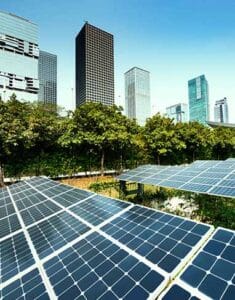
Enquire Now

With every passing year, the world’s technology is advancing along with the progress of several industries like the construction industry. But at the same time, this progress is leading to the regress of the world’s environment which has put the importance of sustainability in the spotlight. Amidst the never-ending issues such as pollution and environmental degradation, sustainability is required immensely and now more than ever.
Needless to say, the implementation of sustainability will be hard to achieve for the construction industry. But with focusing on specific principles such as reusing, conservation and quality, sustainable construction can turn into a reality and promising market.

What is sustainable construction?
Sustainable construction refers to the creation and maintenance of a healthy environment while also reducing the negative impacts on the environment. It includes the use of renewable and recyclable materials while building new structures alongside reducing energy consumption and waste. Its main goal is to reduce the industry’s negative impacts on the environment.
An important factor to remember is that sustainable construction does not simply end when the construction of the building is complete.
Instead, it is when the building has a reduced impact on the environment’s wellbeing throughout its lifespan. For this, the building’s design should integrate elements that impart an ongoing positive influence on the environment. This can be carried out through proper insulation to reduce heat loss, use of solar panels to lessen energy consumption and the overall use of building materials that contain a long lifespan. Rain water harvesting is also a traditional and sustainable initiative that has been used to reduce the pressure on processed water supply while also enhancing green living.

What is the importance of sustainable construction?
The construction industry has a vast impact on the environment, right from energy usages to emissions. It also has the potential of harming wild habitats by building over these ecosystems. Heavy machinery used in the process of construction also depends excessively on fossil fuels, further reducing the energy supply line.
Besides that, fabricating and shipping of materials also has an immense impact on carbon emissions. The mining of raw materials has the potential to pollute local water tables. According to the US Green Building Council, this industry accounts for 38% of all CO2 emissions and 73% of electricity consumption. These figures keep growing over the years.
The construction process can also result in hazardous waste materials and the improper disposal of these waste materials can result in forms of pollution that affect the environment adversely. The effects don’t just end there – they can also harm the health of people and animals living in nearby areas and the effects will be felt for years to come.

How can construction be made sustainable?
Make use of low impact construction materials
Manufacturing construction materials right from scratch requires a lot of energy and natural resources. Hence, it is always beneficial to use low impact materials that are recycled or repurposed. Opt for materials that can be sourced from other building sites or which come from naturally occurring elements. Keep in mind that modular designs also play a big part in minimizing waste and decreasing construction time.
Utilise renewable energy
Sustainable construction can be easily achieved by using an alternative energy source. Great strides of change have been made towards making renewable energy a possibility in terms of construction. For instance, one can use simple methods such as solar, wind and hydro energy to reduce fuel footprint and increase energy savings.
Curtail construction waste
Waste is an inevitable byproduct of any construction site and industry in the form of roofing, cardboard, glass, drywall, insulation, etc. Identify materials that can be reused so that unnecessary waste can be minimised. Large projects also require large quantities of materials and quite a large amount of it can go wasted, so always ensure to weigh raw materials such as MP Birla Cement to avoid wastage of any kind. Other than that, industrial wastes such as fly ash and slag are also used as additional cementitious materials in the manufacturing process.
Keep a check on transportation
Transport is one of the main on-site activities and this generates vast amounts of carbon footprint. To reduce this count, one must use a transportation management system. Besides this, it also aids in monitoring drivers, their speed limits, mapping out the best routes and helping in an overall reduction of air pollution substantially. Moreover, locally available aggregates which are used for the best cement for construction work process also aid in reducing transportation activities, which in turn aids in reducing the carbon footprint. The shift to sustainability while overcoming environmental hazards cannot occur overnight. It requires a lot of patience, research, innovation and creativity from stakeholders. However, switching to sustainable construction is definitely the first step towards that direction.






